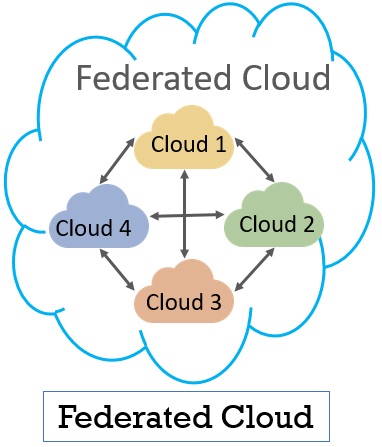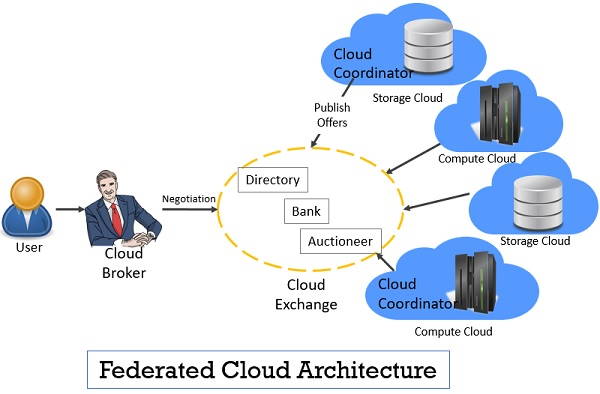Federated cloud is a seamless environment formed by connecting the cloud environment of two or more cloud service provider using a common standard. Federated cloud integrates heterogeneous cloud environment such as community cloud, public cloud, and private cloud in order to scale up the resources and services for the users.
In this section, we will discuss federation in the cloud along with its architecture and types of federation. We will also discuss the properties of a federated cloud environment and its advantages.
Content: Federated Cloud
- What is Federated Cloud?
- Federated Cloud Architecture
- Cloud Federation Properties
- Types of Federation in Cloud
- Advantages of Federated Cloud
- Key Takeaways
What is the Federation in Cloud?
Cloud computing offers computing resources such as servers, databases, storage, networking, runtime environment, virtualization, & software to its customer on their demand over the internet. Customers consume these cloud services with pay as you go pricing model.

Now the term federation is associated with the cloud. Federation means associating small divisions to a single group for performing a common task. Federated cloud is formed by connecting the cloud environment of several cloud providers using a common standard. This federation in the cloud helps the provider to easily scale up the resource to match business needs.
Federated Cloud Architecture
The architecture has three basic components discussed below:
1. Cloud Exchange
The Cloud Exchange act as a moderator between cloud coordinator and cloud broker. The cloud exchange maps the demands of the cloud broker to the available services offered by the coordinator. The cloud exchange has the track record of what is the current cost, demand patterns and available cloud providers and this information is periodically updated by the cloud coordinator.
The cloud brokers interact with cloud exchange to gain information about the existing SLA policies, availability of resources offered by the cloud providers.
Following are the services offered by cloud exchange to both cloud broker and cloud coordinator.
- Database Repository: Cloud exchange act as a database repository or directory where cloud broker announces their resources, service and the price they offer for the services. The customer then analyze this repository to search the most appropriate service and price suiting them and place a request for the service
- Dealer: The cloud exchanger always updates policies of its participants, they always act as a third party between broker and coordinator.
- Bank: Cloud exchanger facilitates the financial transaction between cloud vendors and its clients thus maintaining the trust.
2. Cloud Coordinator
The cloud controller manages the cloud enterprises and their membership. The cloud coordinator allocates the cloud resources to the remote users based on the quality of service they demand and the credits they have in the cloud bank. Based on the policies of SLA the marketing and pricing policies are developed by the cloud coordinator.
3. Cloud Broker
On behalf of the customer, it is the cloud broker who interacts with the cloud coordinator, analyzes the SLA agreement, resources offered by different cloud providers in cloud exchange. Cloud broker finalized the most appropriate deal for their client.

Cloud Federation Properties
Cloud federation properties can be classified into two categories i.e. functional cloud federation properties and usage cloud federation properties.
Functional Cloud Federation Properties
1. Authentication: Cloud federation has the involvement of several foreign resources that have participated in the federation. To consume these foreign resource customer must be provided with the access credential relevant to the target foreign resource. However, the respective foreign resource must also have authentication information of the customer.
2. Integrity: Integrity in the federated cloud offers and demand consistent resources by the providers participated in the federation. If the federated cloud environment lacks in providing the resources its purpose becomes questionable.
To maintain the consistency of the environment management is needed by the providers they can even designate a federation administrative board or the provider can automate the process which will trigger the administrative action when any irregularity is detected.
3. Monitoring: Federated cloud can be monitored in two ways global monitoring and monitoring as a service (MaaS). Global monitoring aids in maintaining the federated cloud. MaaS provides information that helps in tracking contracted services to the customer.
4. Object: Marketing object in cloud computing are infrastructure, software, platform that are offered to the customer as a service. These objects have to pass through federation when consumed in the federated cloud.
5. Contracts: In cloud computing, the agreement between provider and consumer i.e. service level agreement (SLA) has both technical as well as administrative commitments between provider and consumer. In addition to SLA federated cloud has a federation level agreement that encloses commitment to the functional and usage properties.
6. Provisioning: Allocating services and resources offered by the cloud provider to the customer through federation. It can be done manually or automatically. In an automatic way, the best provider is chosen to allocate the resources and services to the customer. In the manual way entity in the federation selects the provider to allocate the resources and services.
7. Service Management: Service management discovers and publishes the services offered by the federated cloud.
8. Interoperability: Interoperability is a mechanism with which the customer’s system is able to interact with the cloud service or cloud service in the federation is able to interact with other cloud services.
9. Commercialization: The providers participated in federation publish their offers to a central entity. The customer interacts with this central entity to verify the prices and propose an offer.
Usage Cloud Federation Properties
1. Interaction Architecture: In the federated cloud, the customers can interact with the architecture either centrally or in a decentralized manner. In centralized interaction, the customer has interacted with a broker to mediate between them and the organization. Decentralized interaction allows the customer to interact directly with the clouds in the federation.
2. Expansion: Expansion of federation depend on how the resources and services in the federation are used.
3. Centric: The federated cloud focuses on the implementation and usability of elements in the federated cloud architecture. The four centrics of the federated cloud are customer, business, provider, service. The federated cloud architecture and mechanism are designed prioritizing the customer. Business-centric focuses on the monetization. Provider centric focuses on maximizing the use of resources and services. Service centric focus on the services and their specialities.
4. Practice Niche: Federated cloud can be practised with different niches like commercial and non-commercial.
5. Volunteer: The providers must voluntarily involve in the federation and must be able to take the decision to leave the federation when they require.
6. Visibility: Visibility of a federated cloud helps the customer to interpret the organization of multiple clouds in the federated environment.
Types of Federation in Cloud
Federation in the cloud is an ability to connect two or more cloud computing environment of distinct cloud service providers. The federation can be classified into four types.
- Permissive federation
Permissive federation allows the interconnection of the cloud environment of two service providers without the verifying identity of peer cloud using DNS lookups. This raises the chances of domain spoofing.
- Verified Federation
Verified federation allows interconnection of the cloud environment, two service providers, only after the peer cloud is identified using the information obtained from DNS. Though the identity verification prevents spoofing the connection is still not encrypted and there are chances of DNS attack.
- Encrypted Federation
Encrypted federation allows interconnection of the cloud environment of two services provider only if the peer cloud supports transport layer security (TSL). The peer cloud interested in the federation must provide the digital certificate which still provides mutual authentication. Thus encrypted federation results in weak identity verification.
- Trusted Federation
Trusted federation allows two clouds from different provider to connect only under a provision that the peer cloud support TSL along with that it provides a digital certificate authorized by the certification authority (CA) that is trusted by the authenticating cloud.
Advantages of Federated Cloud
- Federated cloud allows scaling up of resources.
- Federated cloud increases reliability.
- Federated cloud has increased collaboration of cloud resources.
- Connects multiple cloud service provider globally to let providers buy and sell their services on demand.
- Dynamic scalability reduces the cost and time of providers.
Key Takeaways
- Federated cloud is interconnected cloud environment of multiple cloud service provider.
- Federation of cloud can be done in permissive, verified, encrypted or trusted way.
- The federated cloud architecture has a cloud broker, cloud exchange and cloud coordinator as three basic components.
The federation in the cloud comes with a challenge as the cloud environment participating in the federation are heterogeneous. Along with that building, a federated cloud means building a seamless cloud environment which can interact with people, various devices, different application interfaces and other entities.

Leave a Reply